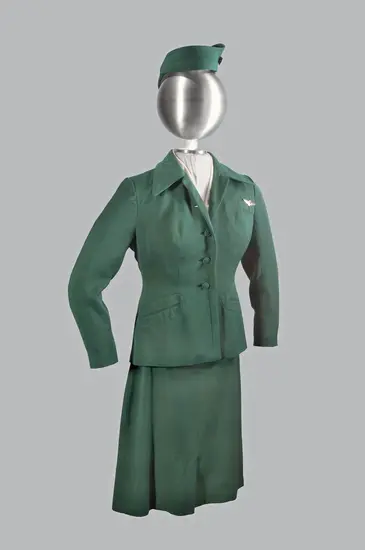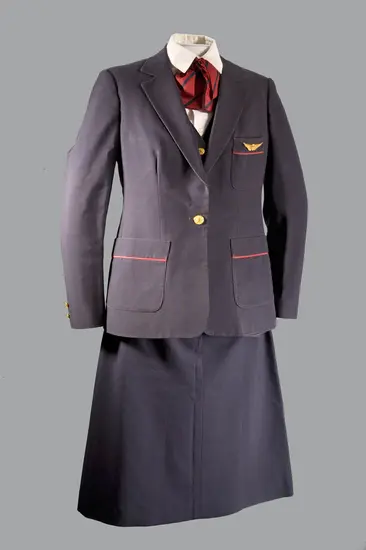
Flight Attendants
Flight attendants are the friendly faces that assist us through our time on an airplane. They teach us aircraft safety, answer questions, ease our fears, and provide exemplary service. But what are the origins of flight attendants? What about their distinctive uniforms? What role did they play in the fight for civil rights?
Though a woman wouldn't pilot a commercial airliner until 1973, by the early 1930s women were entering the ranks of flight attendants. While Pan Am and other airlines employed men as flight attendants, Boeing Air Transport introduced the first women flight attendants in 1930. For a time, women would become synonymous with the flight attendant profession—largely because they could be paid lower wages than men, and because of sexist marketing practices which advertised beautiful woman to attract customers. As social changes swept the nation in the latter half of the 20th century, both women and men fought for equality and respect in the profession.

The First Stewardess
Ellen Church
A nurse from Iowa, Ellen Church wanted to become an airline pilot but realized that wasn’t possible for a woman in her day. So in 1930 she approached Steve Stimpson at Boeing Air Transport with the novel idea of placing nurses aboard airliners. She convinced him that the presence of women nurses would help relieve the traveling public’s fear of flying. Church first flew as a stewardess between Oakland and Chicago. She had only served for 18 months when an automobile accident grounded her. After her recovery, she completed her college degree and returned to nursing.

The Original Eight
Ellen Church developed the job description and training program for the first stewardesses. These are the “Original Eight” female flight attendants for Boeing Air Transport (later United Air Lines). They trained under the program developed by Ellen Church in 1930.
The first stewardess uniform was made of dark green wool with a matching green and gray wool cape. United Air Lines made this replica and donated it in commemoration of Ellen Church, the first stewardess, and the rest of United's
The First Stewardess Uniform
By the early 1930s, airlines were introducing distinctive uniforms for their employees. These uniforms promoted the prestige and allure of aviation staff. Pilots wore military-style uniforms to reflect their status. Pan American emulated luxurious ocean liner service by calling its pilots “captains,” and dressing its crews in naval-style uniforms. The white hats and navy-blue, double-breasted jackets complemented the rank insignia on the sleeve cuffs. Other airlines followed, and many of these customs continue today.
The first stewardess uniform was made of dark green wool with a matching green and gray wool cape. United Air Lines made this replica (left) and donated it in commemoration of Ellen Church, the first stewardess, and the rest of United’s “Original Eight” females.

Fashion at 20,000 Feet
While fashion accessories may not be the first thing that comes to mind when thinking of the National Air and Space Museum, the Museum's collection captures the diversity and playfulness of flight crew dress across the decades. Regardless of age or function, all these accessories require conservation examinations and treatments to prepare them for display.

Read More About Flight Attending Firsts
Jean Harman became Trans World Airline (TWA)'s first flight attendant in 1934. Ruth Carol Taylor served as a flight attendant for Mohawk Airlines in 1958; she was the first African American flight attendant. Read about these stories and other flight attending firsts.
What's in a name?
What we’ve called flight attendants over the years reflects how we’ve thought of them and who they could be.
Steward
When these jobs were created, airlines borrowed the name from jobs held on passenger ships. Only white men could be hired.
Stewardess & Steward
It started with Ellen Church, a nurse, who became the first female flight attendant in 1930. She successfully argued that a nurse on board would calm people’s fears of flying. White men and white women made up the ranks of flight attendants.
Stewardess & Hostess
By the 1950s, women dominated the profession. Sexist restrictions caused a large turnover of women, but airlines could pay them less than men, who tended to stay in their jobs longer. Airlines promoted a glamorous image of female flight attendants to attract male passengers. Typically, only young, attractive, unmarried, white women could be stewardesses, or “hostesses,” which also became popular. However, Ruth Carol Taylor challenged that standard when she became the first African American flight attendant in 1958. By the 1960s, the term "steward" all but disappeared.
In the late 1970s
Following civil rights laws and societal changes, the gender-neutral “flight attendant” became preferred over the outdated “stewardess.”

What Role Did Fashion Play in Commercial Flight?
"I didn't want to put my uniform on and when I finally forced myself to, I felt worthless, an object..."
Air fares were regulated by the government until 1978, which meant airlines needed to look for ways other than low fares to attract passengers, especially businessmen. They offered such amenities as better food, drinks, and movies. One area in which commercial airlines were able to make a splash and successfully market themselves was through what their flight attendants wore. To appeal to male travelers, airlines chose revealing uniforms rather than practical ones, to the discomfort of most flight attendants.
Social Change in the Airline Industry
The dramatic social and cultural changes of the 1960s and 1970s profoundly affected commercial aviation. Barriers against the widespread participation of women and people of color began to fall. Airlines began to hire women and African Americans as pilots. In the early 1990s, United became the first airline to issue an official maternity uniform for its female pilots. By then the industry and the traveling public had accepted that all qualified people, regardless of race or gender, could work aboard an airliner.

Meet the Flight Attendants Who Fought For Equality
Flight attendants were one of the first groups to file a case under Title VII of the Civil Rights Act of 1964, which made biased hiring practices illegal. As social attitudes evolved, they challenged these biased rules through the courts.

Fly the Friendly Skies
In the 1970s, when a court case forced airlines to hire men and women on equal terms and more men became flight attendants, gay men created a community within the industry that was uniquely supportive and welcoming. The next few decades would test that community, first with changes to how airlines were allowed to operate, and then by the AIDS crisis.
In this podcast episode of QueerSpace, we talk to Plane Queer author Phil Tiemeyer and former flight attendant David Hinson to explore that community. QueerSpace is a limited series from the creators of AirSpace, featuring stories and people at the intersection of aviation, space, and LGBTQ+ history and culture.
No Longer a Marketing Tool
From Stewardess to Flight Attendant
Reflecting the social changes of the 1960s and 1970s, the term “stewardess” evolved into the gender-neutral “flight attendant.” Conservative uniform styles reappeared due to new laws that prohibited discrimination in hiring based on age, appearance, and gender. Men now returned to the profession. After the federal government deregulated commercial aviation, the airlines were free to compete by offering low fares, frequent service, and more routes. As a result, airlines no longer felt the need to hire only attractive young women to appeal to male passengers.
Business-style uniforms returned to the sky following deregulation. Stylish yet functional uniforms heightened the sense of professionalism of the cabin crew. These comfortable uniforms were designed for functionality rather than marketing, and enhanced employee productivity.
Flight Fashion Throughout the 20th Century
The way flight attendants have dressed throughout history has often reflected the state of the country, and its relationship to commercial air flight as a whole. For example, at the onset of commercial air flight, flight attendant uniforms mimicked military styles in order to project a sense of authority and professionalism just as the rest of the flight crews' uniforms did.
In the 1960s and 70s, changing social attitudes in the United States paved the way for uniforms more aligned with the fashions of the period, such as mini skirts and go-go boots—though this also lead to exploitation of many female flight attendant who were used to lure male passengers to airlines. By the 1980s, with the deregulation of the airlines, and many years of fighting for gender equality, flight attendant uniforms had returned to a more conservative look, mimicking that of business-style clothing. Take a look through some of the various flying fashion found in the Museum's collection in the gallery below.




















